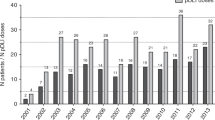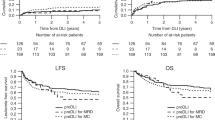Summary:
Achievement of complete donor hematopoietic chimerism (CC) is the goal of allogeneic stem cell transplantation (allo-SCT). Persistence of recipient hematopoiesis augments the risk of relapse, which is one of the main reasons for mortality after allo-SCT. Another main reason for morbidity and mortality is severe extensive chronic graft-versus-host disease (cGvHD). We examined chimerism in peripheral blood of 54 allogeneic stem cell recipients using multiplex STR-PCR method and compared it with the timing and severity of cGvHD. In total, 25 patients achieved early CC (by day 100 post transplant) at a median time of 60 days. In total, 21 of them developed extensive cGvHD. In those patients CC uniformly preceded emergence of cGvHD by a mean of 85 days. A total of 26 patients obtained late CC at a median time of 270 days post transplant. Of this group, only eight patients developed extensive disease. Development of cGvHD in those patients preceded achievement of CC in 10 of 13 cases by a mean of 100 days. The difference between early and late CC groups as to the frequency of the extensive cGvHD was statistically significant (P<0.001). Also, there was a significant correlation of the time of CC and time between CC and cGvHD. Additionally, patients with early CC developed significantly more severe cGvHD measured by the need of three-drug treatment to control the disease (P<0.005). It can be concluded that achievement of early complete donor hematopoietic chimerism in peripheral blood is strongly predictive of severe extensive GvHD.
This is a preview of subscription content, access via your institution
Access options
Subscribe to this journal
Receive 12 print issues and online access
$259.00 per year
only $21.58 per issue
Buy this article
- Purchase on Springer Link
- Instant access to full article PDF
Prices may be subject to local taxes which are calculated during checkout



Similar content being viewed by others
References
Antin JH, Childs R, Filipovich AH et al. Establishment of complete and mixed donor chimerism after allogenic lymphohematopoietic transplantation: recommendations from a workshop at the 2001 tandem meetings. Biol Blood Marrow Transplant 2001; 7: 473–485.
Huss R, Deeg HJ, Gooley T et al. Effect of mixed chimerism on graft-versus-host disease, disease recurrence and survival after HLA-identical marrow transplantation for aplastic anemia or chronic myelogenous leukemia. Bone Marrow Transplant 1996; 18: 767–776.
Chalandon Y, Vischer S, Helg C et al. Quantitative analysis of chimerism after allogeneic stem cell transplantation by PCR amplification of microsatellite markers and capillary electrophoresis with fluorescence detection: the Geneva experience. Leukemia 2003; 17: 228–231.
Khan F, Agarwal A, Agrawal S . Significance of chimerism in hematopoietic stem cell transplantation: new variations on an old theme. Bone Marrow Transplant 2004; 34: 1–12.
Storb R, Deeg HJ, Whitehead J et al. Methotrexate and cyclosporine compared with cyclopsporine alone for prophylaxis of acute graft versus host disease after marrow transplantation for leukemia. N Engl J Med 1986; 314: 729–735.
Przepiorka D, Weisdorf D, Martin P et al. 1994 consensus conference on acute GVHD grading. Bone Marrow Transplant 1995; 15: 825–828.
Schulman HM, Sullivan KM, Weiden PL et al. Chronic graft-versus-host syndrome in man. A long term clinicopathologic study of 20 Seatle patients. Am J Med 1980; 69: 204–217.
Gardiner N, Lawler M, O'Riordan J et al. Persistent donor chimaerism is consistent with disease-free survival following BMT for chronic myeloid leukaemia. Bone Marrow Transplant 1997; 20: 235–241.
Schattenberg A, De Witte T, Salden M et al. Mixed hematopoietic chimerism after allogenic transplantation with lymphocyte-depleted bone marrow is not associated with a higher incidence of relapse. Blood 1989; 74: 1367–1372.
Mangioni S, Balduzzi A, Rivolta A et al. Long-term persistence of hemopoietic chimerism following sex-mismatched bone marrow transplantataion. Bone Marrow Transplant 1996; 20: 969–973.
Molloy K, Goulden N, Lawler M et al. Patterns of hematopoietic chimerism following bone marrow transplantation for childhood acute lymphoblastic leukemia from volunteer unrelated. Blood 1996; 87: 3027–3031.
Dubovsky J, Daxberger H, Fritsch G et al. Kinetics of chimerism during the early post-transplant period in pediatric patients with malignant and non-malignant hematologic disorders: implications for timely detection of engraftment, graft failure and rejection. Leukemia 1999; 13: 2059–2069.
Colson YL, Boggs SS, Patrene KD, Ildstad ST . Durable mixed allogenic chimerism and tolerance by a normal radiation-based cytoreductive approach. J Transplant 1996; 157: 2828–2829.
Wekerle TH, Blaha P, Asari R et al. Tolerance induction through mixed chimerism. Eur Surg 2002; 34: 131–136.
Schaap N, Schattenberg A, Mensink E et al. Long-term follow-up of persisting mixed chiemrism after partially T cell-depleted allogenic stem cell transplantation. Leukemia 2002; 16: 13–21.
Umemura A, Morita H, Li XC et al. Dissociation of hemopoetic chimerism and allograft tolerance after allogenic bone marrow transplantation. J Immunol 2001; 167: 3043–3048.
Mapara MY, Kim YK, Wang S et al. Donor lymphocyte infusions mediate superior graft-versus-leukemia effects in mixed compared to fully allogenic chimeras: a critical role for host antigen-presenting cells. Blood 2002; 100: 1903–1909.
Sykes M, Sachs DH . Mixed chimerism. Philos Trans Roy Soc London B 2001; 1409: 707–726.
Chakrabaratti S, Handa SK, Bryon RJ et al. Will mixed chimerism cure autoimmune diseases after a nonmyeloablative stem cell transplant. Transplantation 2001; 72: 340–342.
Wren SM, Hronakes ML, Iidstad ST . CD4+ T cells, but not CD8+ T cells, mediate the breaking of tolerance in mixed allogenic chimeras (B10+B10.BR → B10). Transplantation 1993; 55: 1382–1389.
Imammura M, Tsutsumi Y, Miura Y et al. Immune reconstitution and tolerance after allogenic hematopoietic stem cell transplantation. Hematology 2003; 8: 19–26.
Toh HC, Spitzer TR, Preffer F et al. Fluctuating lymphoctes chimerism, tolerance and anti-tumor response in patient with refractory lymphoma receiving nonmyeloalative conditioning and a haploidentical related allogeneic bone marrow transplant. Cytokines Cell Mol Ther 2002; 7: 43–47.
Lion T, Daxberger H, Dubovsky J et al. Analysis of chimerism within specific leukocyte subsets for detection of residual or recurrent leukemia in pediatric patients with allogenic stem cell transplantation. Leukemia 2001; 15: 307–310.
Winiarski J, Gustafsson A, Wester D, Dalianis T . Follow-up of chimerism, including T- and B-lymphocytes and granulocytes in children more than one year after allogenic marrow transplantation. Pediatr Transplant 2000; 4: 132–139.
Chabannom C, Lafage M, Mozziconacci MJ et al. Early establishment of chimerism in the B and T lymphoid lineages after transplanatation of allogenic mobilized blood cells in leukemic patients. Transplantation 1997; 63: 1646–1652.
Acknowledgements
The research was supported by grant from the State Committee of Scientific Research 4PO5BO4419 (Poland).
Author information
Authors and Affiliations
Corresponding author
Rights and permissions
About this article
Cite this article
Balon, J., Hałaburda, K., Bieniaszewska, M. et al. Early complete donor hematopoietic chimerism in peripheral blood indicates the risk of extensive graft-versus-host disease. Bone Marrow Transplant 35, 1083–1088 (2005). https://doi.org/10.1038/sj.bmt.1704962
Received:
Accepted:
Published:
Issue Date:
DOI: https://doi.org/10.1038/sj.bmt.1704962
Keywords
This article is cited by
-
Impact of T-cell chimerism on relapse after cord blood transplantation for hematological malignancies: Nagoya Blood and Marrow Transplantation Group study
Bone Marrow Transplantation (2017)
-
Chimerism status is correlated to acute graft-versus-host disease after allogeneic stem cell transplantation
International Journal of Hematology (2014)
-
Clinical outcomes of late rather than early full-donor chimerism in patients with advanced lymphomas receiving nonmyeloablative allogeneic hematopoietic SCT
Bone Marrow Transplantation (2008)
-
Influence of conditioning regimens and stem cell sources on donor-type chimerism early after stem cell transplantation
Annals of Hematology (2008)
-
Engraftment kinetics and hematopoietic chimerism after reduced-intensity conditioning with fludarabine and treosulfan before allogeneic stem cell transplantation
Annals of Hematology (2007)



